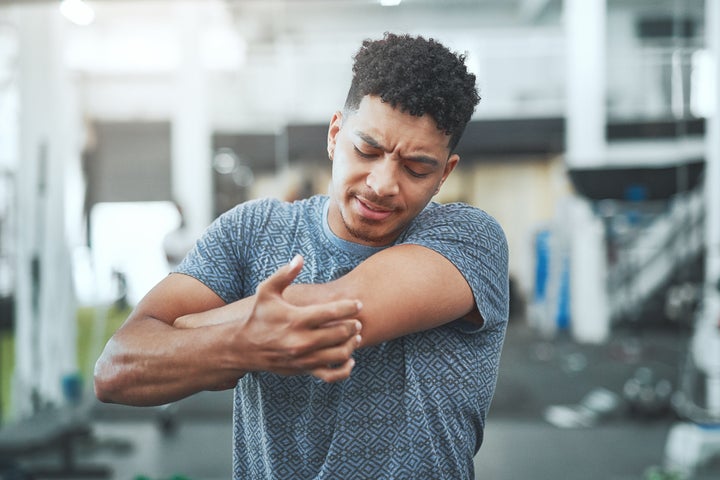
Every year brings new viral wellness trends that are often touted as be-all end-all magic. And while some of these trends are science-backed and beneficial, others are just not.
This year saw we saw a fair share of fads, from magnesium for sleep and stress to primal movement to the continued popularity of walking. We asked both mental health and fitness experts to break down the worst trends to emerge in 2023. Here’s what they are and why you should hesitate doing them.
The ‘75 Hard’ Challenge
“The 75 Hard Challenge is the worst fitness trend I saw on social media this year,” Marley Bigos, an instructor at Barry’s LA, told HuffPost via email.
Bigos explained that the 75-day challenge requires people to do four things: follow a strict, specific diet of their choice with no alcohol or “cheat meals,” do two 45-minute workouts each day, drink a gallon of water every day and take daily progress pictures.
This is not a sustainable or healthy way to go about health and fitness.
“Following a specific diet with no room for error is unsustainable, mentally draining and has the potential to aid in the development of disordered eating,” Bigos said.
When it comes to exercising so much, that’s problematic, too. “Working out twice a day is very taxing, but it’s safe and doable assuming someone is taking real rest days, as well as putting forth a strong focus on recovery [like foam rolling and stretching],” Bigos said. “Mandating someone to workout twice a day for 75 days without taking a break is incredibly dangerous. There’s no reason for anyone to ever put that much stress on their body.”
Additionally, she said, the gallon of water per day aspect doesn’t take into account someone’s weight, energy output or climate. Water consumption is not a one-size-fits-all thing.
Lastly, “taking pictures every single day is highly unnecessary. While I do understand someone wanting to take pictures at the beginning of a fitness journey, taking them every day could easily encourage an unhealthy hyper-fixation on outward appearance, instead of putting forth energy to maintain a nutrient-rich diet and safe exercise plan,” Bigos said.
Closing Your Rings Every Single Day
Reminders from fitness trackers and pressure from fitness influencers online can encourage a culture of overtraining. Many people often strive to “close their rings” on their Apple Watch or complete activity goals on their fitness trackers. While this generally is a good goal, not prioritising rest for the sake of completing a digital milestone isn’t.
James McMillian, a coach and director of product and innovation at Tone House in New York, said it is one of the most problematic trends in the industry.
“People glorify that overtraining and that concept of the no days off, and they have an increased risk of injury and less recovery and a rest,” McMillian said.
Your body needs time to rest and refuel. Rest days allow your body’s energy stores to replenish, gives your muscles time to repair and helps you heal from any soreness.
But McMillian said he sees people online encouraging their followers to work out at full effort 365 days a year.
“That is not obtainable for every single person, especially with their schedule, their lifestyle, their family, their career, as well as their health, you cannot do it every single day, you’ve got to have some recovery days,” McMillian said.
AI Workouts
According to Scott Brown, vice president of fitness at Orangetheory, the fitness industry saw an increase in the use of AI in 2023.
“This trend itself isn’t necessarily problematic, but it becomes a concerning shift when AI supplants the human element that is vital in fitness,” he told HuffPost via email.
“From AI coaches to ChatGPT-created workouts, this over-reliance on AI is problematic because currently AI often misses the specific nuances and customisation of protocols based on an individual’s considerations,” Brown said.
For example, AI isn’t going to understand your fitness history like a personal trainer you’ve been working with for years will.
“AI also misses the sense of community, empathy and motivation that human coaches and group settings deliver,” he said, adding that this is important for a consistent and successful fitness journey.

Misusing Therapy Speak
When pondering this year’s wellness trends, “the first thing I thought about was all the trending psychology buzzwords that I see when people are posting on social media — words like boundaries, triggered, gaslighting, intrusive thoughts ... those kinds of trending psychology terms,” said Maggie Lancioni, a licensed professional counselor based in New Jersey.
These trending psychology terms are commonly known as “therapy speak” and can be helpful, but Lancioni said she often sees people using them cavalierly. “People are just totally missing the true meaning of how impactful these things really are to someone.”
For example, Lancioni said, she’s seen people weaponise the word boundary as “limits they set for other people — trying to control other people’s behaviours ... that’s not what a boundary is.” Instead, “boundaries are our personal limits ― whether that be physical, emotional, etc. ― within relationships to others,” Lancioni explained.
Examples include declining events you don’t want to attend. “A simple sentence like ‘no’ is a boundary you’re drawing with another person,” she said. Personal space boundaries, like telling someone you’re not a hugger, is another example.
Self-Diagnosing ADHD Or Other Disorders On Social Media
While many people look at WebMD for their medical concerns, more and more people are turning to social media for mental health support. While that is not in itself problematic, it turns problematic when people rely on social media for diagnoses of mental health disorders.
“What I see on social media is a lot of self-diagnosing going on,” Lancioni said.
“For instance, people thinking ‘I’m so tired, so I must be depressed’ or ‘I can’t concentrate, so I must have ADHD.’”
ADHD, in particular, has gained a lot of attention on platforms like TikTok. Short videos describing broad symptoms have infiltrated the app, leading to many users commenting and questioning whether they have the condition. Not all of this is bad, of course; social media can be a great tool for learning more about yourself or recognizing signs of something deeper. It’s what people do — or rather, don’t do ― after they self-diagnose that can be problematic.
“It’s really hard on social media because therapy is such an individualized experience ... it’s good to spread the awareness of what certain diagnoses and what certain criteria are. However, for true formal diagnosis, you can’t necessarily get that on social media ― you would need to see a licensed professional,” Lancioni said.
Relying On Influencers For Health Advice
This is an unfortunate physical health trend and mental health trend, both Lancioni and McMillian said.
“Having a great body, a great following, cool workouts, a nice clear camera does not qualify you as an expert,” McMillian said. “It only makes you an entertainer unless you’re certified.”
While certain workouts or practices may have helped an influencer on social media, it doesn’t mean it will work for you, McMillian said. “Everybody has different body types, they have different hip alignments, different height, they have different strengths.”
“If you’re out here trying to do what I’m doing on Instagram, you may not get to your goal ... So, always seek an expert and that will help you even more,” McMillian continued.
In terms of mental health, this is true, too. “I see a lot of accounts portraying themselves as mental health experts with no license or with no credibility,” Lancioni said. She stressed that it’s important to follow credible sources — as in experts with a license to practice mental health and psychology.
McMillian added that people should be able to speak on their experience and share what worked for them, but it shouldn’t be given as formulaic advice to their followers, too.
Using Berberine For Weight Loss
This year, Ozempic, a medication originally used to treat diabetes, exploded in popularity because of its off-label use for weight loss (it also has on-label use for weight loss when marketed as Wegovy). However, the medicine is expensive and requires a prescription, leading many people to look for cheaper alternatives that claim to do the same thing.
On TikTok, an alternative that gained popularity is berberine ― an herbal supplement dubbed “nature’s Ozempic” ― which many people on social media said resulted in weight changes. But experts aren’t so sure.
“The best inference we can make on berberine’s potential for weight loss comes from a similar compound, metformin,” Dr. Anant Vinjamoori, the chief medical officer at Modern Age, previously told HuffPost. “Metformin has been shown only to produce about a 3 to 5% weight loss at best.”
Additionally, berberine is not approved as a weight-loss treatment by the Food and Drug Administration, and it can have some side effects. The supplement is commonly used short-term ― about two weeks ― in people with irritable bowel syndrome, Heather Munnelly, a functional nutritional therapy practitioner, previously told HuffPost. Using the supplement longer than this amount of time can be harmful, Munnelly said.
Side effects include nausea and diarrhea, and there’s also a risk that it could interfere with other medications, according to the Mayo Clinic.
Suffice it to say, its weight-loss results aren’t proven, and it could be harmful for some folks. Talk to your doctor before starting this supplement.

In the end, wellness should be about what keeps you happy and healthy ― even if it’s not trendy.
“Generally, I’ll support any fitness trend that gets people moving. However, it’s important to remember that just because it’s a trend, that doesn’t mean that it’s safe, effective or the right choice for your fitness goals specifically,” Brown said. “I encourage everyone to look beyond the hype of trends and choose fitness routines that offer realistic and sustainable methods for achieving their health and wellness goals, and to seek out and rely on certified experts in the field.”
As for your mental health, it’s important to remember that advice on social media is going out to huge numbers of people, but that doesn’t mean it’s applicable to everyone. If you find something that resonates, you can use it as a talking point with your therapist (or as a catalyst to start therapy), Lancioni said.
“I’m a huge proponent, obviously, for people going to therapy because I just think that everyone’s life and experiences are just so, so, so unique. And you might experience some similar symptoms as other people, however, your life experiences have been so different from other[s],” Lancioni added.
Lancioni noted that while therapy is not accessible for all, more and more programs are helping with that hurdle. Check out Open Path Psychotherapy Collective for more accessible pricing or check in with therapists in your area to see if they offer sliding scale appointments or pro bono work.
There is not one path to feeling your best, either physically or mentally, and a trend certainly shouldn’t be the one way you approach your health.